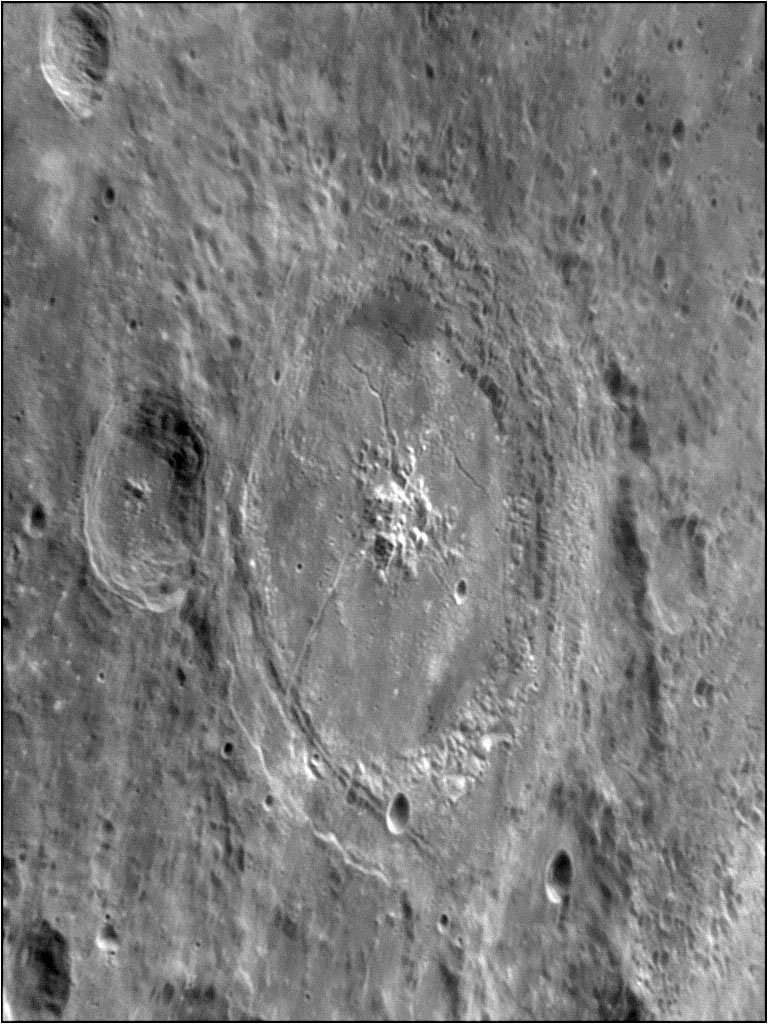|
 Petavius
est un exceptionnel cratère à fond fracturé de 177 Km et profond de 3300 m,
à chaîne de montagnes centrale
situé à l'extrémité sud de Mare Fecunditatis (Mer de la Fécondité).
Le massif montagneux
s'élève à 1 700 m d'altitude.
Dans l’arène un système de rainures long de 80 Km orientées Nord-est
Sud-ouest se révèlent lors d’une observation deux jours après la pleine lune
(Jour 16 de la lunaison*).
A noter une
rainure radiale remarquable orientée
sud-ouest qui relie la montagne centrale au bord du cratère Ainsi que
quelques taches sombres.
Le rempart de son enceinte, qui se dédouble à l'ouest, s'élève par endroit
à 3 300 m d'altitude et comporte de larges terrasses. Au Nord-ouest de
Petavius se trouve accolé le cratère Wrottesley (57 Km) à piton central.
Petavius
est un exceptionnel cratère à fond fracturé de 177 Km et profond de 3300 m,
à chaîne de montagnes centrale
situé à l'extrémité sud de Mare Fecunditatis (Mer de la Fécondité).
Le massif montagneux
s'élève à 1 700 m d'altitude.
Dans l’arène un système de rainures long de 80 Km orientées Nord-est
Sud-ouest se révèlent lors d’une observation deux jours après la pleine lune
(Jour 16 de la lunaison*).
A noter une
rainure radiale remarquable orientée
sud-ouest qui relie la montagne centrale au bord du cratère Ainsi que
quelques taches sombres.
Le rempart de son enceinte, qui se dédouble à l'ouest, s'élève par endroit
à 3 300 m d'altitude et comporte de larges terrasses. Au Nord-ouest de
Petavius se trouve accolé le cratère Wrottesley (57 Km) à piton central.
 (English version,
Wikipedia copyright)
(English version,
Wikipedia copyright)
Petavius
is a large lunar impact crater located to the southeast of the Mare
Fecunditatis, near the southeastern lunar limb. Attached to the northwest
rim is the smaller Wrottesley crater. To the southeast are Palitzsch crater,
Vallis Palizsch, and Hase crater. Further to the north is the large
Vendelinus crater. The crater Petavius appears oblong when viewed from the
Earth due to foreshortening.
The outer wall of Petavius crater is unusually wide in proportion to the
diameter, and displays a double-rim along the south and west sides. The
height of the rim varies by as much as 50% from the lowest point. The convex
crater floor has been resurfaced by lava flow, and displays a rille system
named the Rimae Petavius. The large central mountains are a prominent
formation with multiple peaks, climbing 1.7 kilometers above the floor. A
deep fracture runs from the peaks toward the southwest rim of the crater.
Rev. T. W. Webb described Petavius as "one of the finest spots in the Moon:
its grand double rampart, on east side nearly 11,000 ft. High, its terraces,
and convex interior with central hill and cleft, compose a magnificent
landscape in the lunar morning or evening, entirely vanishing beneath a Sun
risen but halfway to the meridian."
70cm radar images of this crater and its surroundings show that the region
of the surface beyond the wide outer rampart of Petavius has a dark halo,
characteristic of a smooth surface free of boulders. It is thought that this
may have been created by radial outbursts during the original impact that
swept the area "clean".
Crater Petavius B to the north-northwest of Petavius has a small ray system
that lies across the Mare Fecunditatis surface.
|
|


 Petavius
Petavius